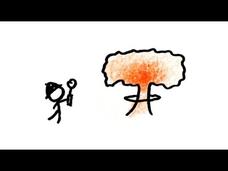Fuse School
What Are Endothermic and Exothermic Reactions?
Investigate the properties of endothermic and exothermic reactions with a detailed video lesson that defines exothermic and endothermic. The instructor explains the properties of each reaction and gives several examples of each.
MinutePhysics
How To Detect A Secret Nuclear Test
Discover how science is ready to protect the world against nuclear explosions. An interesting lesson describes how science monitors the world for evidence of nuclear explosions. By using technology to detect waves, it is possible to...
Veritasium
Levitating Barbecue! Electromagnetic Induction
Who says you shouldn't play with electricity?! Investigate Faraday's Law of Induction through a video demonstration from his hometown. The lesson shows an aluminum plate levitating from the magnetic fields created by electric currents....
FuseSchool
Parallel and Perpendicular Lines
Investigate parallel and perpendicular lines in the coordinate plane. Watch as the instructor demonstrates graphing the two types of lines. She highlights the patterns of the slope or steepness of the pairs of lines to make the concept...
Teacher's Pet
Molecular Compounds
Discover the chemical make-up of molecular compounds. A descriptive video lesson explains the formation of molecular compounds. The video focuses on covalent bonds of non-metals, although it does reference ionic bonding.
Veritasium
The Sun Sneeze Gene
Do you sneeze when you go from dark to light areas? Twenty-five percent of the population does! It turns out that the characteristic is due to genetic code. Explore why this happens with a video from the Veritasium playlist that breaks...
Crash Course
Mean, Median, and Mode: Measures of Central Tendency: Crash Course Statistics #3
If you have two feet, you have more than the average number of feet! Explore the meaning of the numbers of measures of central tendency of different data sets with the third of five lessons in a video statistics playlist. Using unique...
SciShow
Mimas: The Real-Life Death Star
Saturn's moon Mimas has a unique composition worth studying. Mimas has a crater that was created 4.1 billion years ago that altered its composition from core to surface. Scholars learn these unique characteristics as they view an...
Crash Course
Regression: Crash Course Statistics #32
Regression models help make sense of statistical data and assist people in making predictions describing the world around us. A thorough video lesson discusses linear regression models and concepts related to the models, such as...
Anywhere Math
Box-and-Whisker Plots
Whiskers are more than just a cat facial feature! Learn how the whiskers of a box-and-whisker help make conclusions about a data set. An instructor first explains how to create a box-and-whisker and then how to read it. Several examples...
PBS
The Island of Huge Hamsters and Giant Owls
From cute little birds to giant aviary specimens—all animals evolve! Learn how natural selection on an isolated island in the Mediterranean encouraged animals species to increase in size. The narrator discusses fossil evidence that...
PBS
Seismic Waves | UNC-TV Science
No need to wave the white flag. Use an animation to demonstrate the motion of seismic waves instead. A short animation shows the motion of longitudinal and transverse waves. Pupils also learn how the movement displaces the earth.
Brightstorm
Transformations and Isometries
Give your class a solid foundational understanding of transformations. The instructor in a concept video describes each type of transformation and transformation notation. He also identifies the types of transformations that are isometries.
Fuse School
3 States of Matter: Solids, Liquids and Gases
Start your states of matter unit off right with an engaging video! Before scholars can write and balance equations or predict products, knowledge of the three main states of matter is essential. The first in a 14-part series discussing...
Fuse School
Intermolecular Forces
Investigate types of intermolecular forces through a video lesson. The instructor explains the concept of intermolecular forces and the three types. He includes several examples and illustrations of each.
Crash Course
Work, Energy and Power: Crash Course Physics #9
What does work mean to you? Chances are it has a different meaning to a physicist! The ninth video in a physics series discusses the meaning of work, power, and energy. The narrator gives examples and formulas while explaining the...
American Chemical Society
The Science of Caffeine: The World's Most Popular Drug
Discover the science behind the world's most popular drug. Scholars explore the neural effects of caffeine in an episode of the larger ACS Reactions playlist. The presenter explains how caffeine impacts different neurotransmitters in the...
Be Smart
Is Space a Thing?
Travel through time to learn from some of the world's greatest scientists. The narrator of a thought-provoking video investigates the theories of Newton, Mach, and Einstein among others to determine if space itself is a thing. Viewers...
Corbett Maths
Gradient of a Line
Steepness, gradient, and slope all refer to the same feature of a line. Young scholars watch and rewatch a video lesson to build a solid understanding of the relationship between the rise compared to the run of a line. Examples include...
Crash Course
Fitting Models Is like Tetris: Crash Course Statistics #35
Different statistical models tell people unique information about data. The 35th lesson in the Crash Course Statistics series describes two different statistic models: ANOVA and Repeated Measures ANOVA. The narrator of a short video...
Mathispower4u
The Difference Between an Expression and an Equation
Evaluate an expression or solve an equation—two very different tasks! A video tutorial begins by defining an expression and an equation and then discusses the similarities and differences between the two. The instructor also demonstrates...
Mathispower4u
Graphing by Finding Intercepts
There's more than one way to graph a line. A video presentation explores graphing linear equations by finding the intercepts. After explaining the concept of an intercept and how it relates to its coordinates, the presenter demonstrates...
Smithsonian Institution
Natural Selection: Common Misconceptions
Overcoming pupil misconceptions is much harder than teaching a new topic. Anticipate misconceptions to avoid having to reteach and relearn by showing a lesson resource from the Good Thinking PD series that highlights common mistakes. A...
PBS
Light Absorption: Effects of Light | UNC-TV Science
Beat the summer heat by exploring the properties of color. Scientists view a video explaining the relationship between light absorption and energy transfer using variables including intensity, time, and wavelength. A multiple-choice...

























